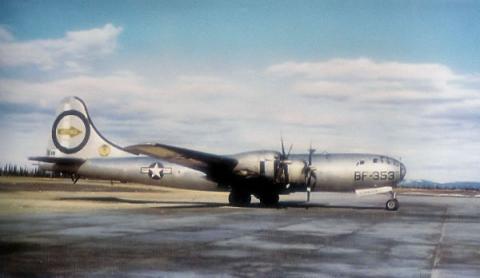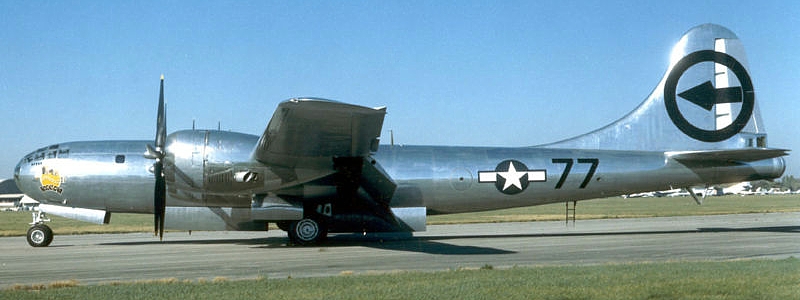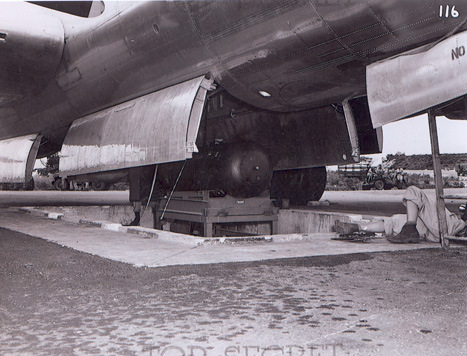Project “Silverplate” was the code name that referred to a secret program within the Manhattan Project to produce a special version of the Boeing B-29 Superfortress bomber that would be capable of delivering the atomic bomb. The code name eventually came to identify the training and operational aspects of the program as well. The Silverplate program was part of a larger operation, Project Alberta, the section of the Manhattan Project tasked with designing a bomb shape for delivery by airplane, conducting ballistic testing of atomic bomb designs, and training aircrews in preparation for deployment overseas.
Initial Phase
Scientists working on the atomic bomb quickly realized that the unusual size and weight of the devices–both the tubular “gun-type fission weapon” shape (Little Boy) and the oval plutonium implosion weapon shape (Fat Man)–would be too large to be delivered by a conventional bomber such as the B-17 or the B-24. In October 1943, Dr. Norman Ramsey, a member of the Los Alamos National Laboratory Group, suggested that the only airplane in the U.S. inventory capable of carrying either type of the proposed weapons shapes was the B-29 Superfortress. Even the B-29, however, would require extensive modifications to both its engines and its bomb bay in order to accommodate the enormous weapon.
Prior to the decision to use the B-29, military officials had given serious consideration to using the British Avro Lancaster to deliver the weapon, which the Royal Air Force had used to deliver the 5-ton Tallboy bombs developed in 1944. The Avro Lancaster would have required much less modification, but Major General Leslie Groves, the commander of the Manhattan Project, and General Henry H. Arnold, the Chief of United States Army Air Forces, wished to use an American plane.
On November 30, 1943, the United States Army Air Forces sent instructions to its Army Air Forces Materiel Command at Wright Field, Ohio, for a highly-classified B-29 modification project. Scientists at working on the Manhattan Project would deliver full-sized mockups of the Little Boy and Fat Man weapons shapes to Wright Field by mid-December, where engineers there would modify the B-29 and equip it for use in bomb flight testing.
The first B-29 arrived at Wright Field, Ohio, on December 2 and underwent extensive modification to the bomb bay. To accommodate the length of the gun-type shaped weapon (Little Boy was originally supposed to be approximately 17 ft, but was later reduced to 10 ft), engineers removed the B-29’s four bomb bay doors and the fuselage section between the bays and replaced them with a single 33 ft bomb bay. This modification project resulted in the removal of all the rear gun stations. Each plane was designed to carry either type of device; either Little Boy type in the forward bay or Fat Man type in the rear. New bomb suspensions and bracing were also implemented and separate twin-release mechanisms were mounted in each bay. Engineers also placed motion picture cameras in the bays to record the test of the new release mechanism.
The modifications, which were done completely by hand, were extensive and time-consuming. The process required more than 6000 man-hours of labor and the first B-29 prototype was not complete until February 20, 1944.
Bomb Shape Testing
Soon after the first heavily-modified silverplate B-29 arrived at Muroc Army Air Field in California in March, military officials began testing the different bomb shapes. On March 6, engineers tested a Thin Man bomb (modeled after Little Boy) followed by two Fat Man tests on March 14. The Thin Man test proved successful, but the Fat Man shapes exhibited significant wobble characteristics due to misalignment of the tail fins. In addition, all three bombs had failed to release immediately. A fourth testing flight resulted in the premature release of a Thin Man shape while the B-29 was still en route to the test range and severely damaged the aircraft. The modified release mechanism was soon replaced with British type releases as used on the Avro Lancaster due to the enormous weight of the bombs.
The Silverplate Fleet
After successful bomb shape testing, a production phase of Silverplate B-29s was ordered on August 22, 1944. By mid-October the first three Silverplate B-29s were delivered to the USAAF and flown to Wendover Army Airfield, Utah. A new crew position, called the “weaponeer station”, was established in the cockpit with a panel to monitor the release and detonation of the bomb during the actual combat drops. Fourteen production aircraft were assigned to the 393rd Bomb Squadron and three to the 216th AAF Base Unit for bomb drop testing to be conducted at Wendover.
The USAAF continued to improve and modify the Silverplate series throughout 1945. The final wartime Silverplates incorporated all technical improvements to B-29 aircraft, as well as the final series of Silverplate modifications that included fuel-injected engines, reversible-pitch propellers, and pneumatic actuators for rapid opening and closing of bomb bay doors. Engineers were also able to significantly reduce the weight of the aircraft by removing all gun turrets and armor plating. These B-29s represented a significant increase in performance over the standard variants.







